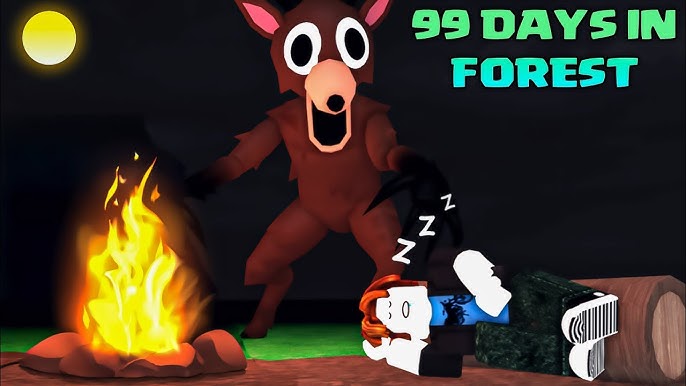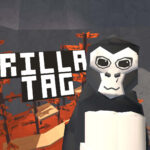99 Nights In The Forest: A Deep Dive into Roblox's Premier Survival Horror
"99 Nights In The Forest" transcends the typical Roblox experience, carving out its own space as a meticulously crafted survival horror game that challenges players on multiple fronts. It’s an intricate blend of narrative suspense, strategic base-building, and psychological terror, all set against a backdrop of a hauntingly beautiful, yet dangerous, cursed landscape. This isn't just a game about surviving; it's a test of endurance, teamwork, and sanity.
The Haunting Lore: A Narrative Built on Dread
The most compelling aspect of "99 Nights In The Forest" is its narrative. The game doesn't rely on a cinematic opening or lengthy cutscenes to establish its lore. Instead, it masterfully employs environmental storytelling. The player learns about the forest's tragic past through discovery—finding scattered notes from previous survivors, deciphering cryptic symbols carved into ancient trees, and observing the unsettling changes in the environment as the curse deepens. This method of storytelling fosters a sense of isolation and dread, making the player an active participant in uncovering the mystery. The forest was once a place of peace, but an ancient ritual, gone horribly wrong, twisted it into a hostile wasteland inhabited by dark spirits. The constant whispers, the eerie silence, and the visual cues hint at a deeper, more sinister truth, leading to player-driven theories about secret endings and the true nature of the curse. This narrative approach transforms the game from a simple survival challenge into a profound psychological journey.
Survival Evolved: Beyond the Basics of Base-Building
The game’s core loop is a masterclass in progressive difficulty. The initial nights are a crucial, yet deceptively calm, introduction to the mechanics. Players are taught to gather essential resources like wood and stone, craft basic tools, and construct a simple shelter. It's a tutorial disguised as a gentle beginning, lulling players into a false sense of security. The first five nights are manageable, but this period is designed to test a team's ability to communicate and coordinate. A team that fails to establish a clear division of labor—one person gathering, another building, and a third scouting—will inevitably be overwhelmed by the challenges that emerge by night 10.
As the nights progress, the survival mechanics become more complex. It's no longer just about building walls; players must manage hunger, warmth, and stamina. Every decision, from how many resources to allocate to a fire versus a new trap, carries weight. The game introduces dynamic challenges that ensure no two nights are the same. Heavy fog reduces visibility to mere feet, making it easy for enemies to sneak up on you. Sudden storms can tear down poorly constructed defenses, forcing teams to scramble for repairs. Supernatural anomalies disrupt electronics, rendering advanced security systems useless and plunging the base into darkness. These variables force players to be perpetually on edge, constantly adapting their strategies to survive the unpredictable environment.
The Bestiary of Nightmares: Enemies That Evolve
The enemies in "99 Nights In The Forest" are far from generic monsters. They are a diverse and terrifying menagerie, each with unique behaviors and threats. The early game presents smaller, more manageable foes like corrupted animals and forest spirits. These creatures serve as a foundational challenge, teaching players the importance of basic defenses and situational awareness. However, as the game progresses, the threats become exponentially more dangerous. By night 30, players encounter creatures like the Wendigo, a hulking beast capable of tearing through wooden walls with terrifying speed.
Boss encounters, which occur every 20 nights, are the game's ultimate tests. These are not just tougher enemies; they are strategic challenges that demand a level of coordination, advanced gear, and tactical planning that is rarely seen in Roblox games. A failed boss fight doesn't end the game, but the consequences are severe. A heavily damaged camp can leave a team vulnerable to subsequent attacks, and the resulting morale drop can be just as devastating as physical damage. The constant escalation of threats ensures that players can never rely on the same strategy for long, pushing them to innovate and prepare for the next, more terrifying challenge.
The Strategic Pillars: Crafting, Building, and Teamwork
At the heart of "99 Nights In The Forest" lies a robust crafting and building system. It’s the primary tool for survival, allowing players to move from basic defenses to a fortified fortress. Early game recipes are simple, focusing on torches, wooden walls, and rudimentary traps. However, as players endure more nights, they unlock advanced technology like motion sensors, energy barriers, and healing stations. This progression is not just about power; it's about shifting from a defensive mindset to a proactive one.
Teamwork is the game’s most critical resource. The most successful teams operate with clear roles: a builder focuses on fortifying the base and managing resources, a scout ventures out to find rare materials and information, a crafter produces essential tools and defenses, and defenders patrol the perimeter to handle immediate threats. This specialization maximizes efficiency and ensures the team is ready for any challenge. Base design is also paramount. A well-designed fortress with strategic choke points and even underground escape tunnels can mean the difference between survival and a swift demise.
While the game is designed for multiplayer, a solo run is possible and presents a unique, high-difficulty challenge. The inability to multitask means a solo player must be constantly on the move, prioritizing what to build and what to gather with every waking moment. The multiplayer experience, however, truly shines. The ability to revive teammates and share crafting bonuses makes cooperation not only rewarding but essential for reaching the later stages of the game.
The Endgame: A Descent into Chaos and Hallucinations
By night 50, the forest is no longer just a dangerous place; it's a surreal and unsettling reality. Bioluminescent fungi cast an ominous glow, trees groan with unnatural sounds, and reality itself begins to bend. Gravity-defying anomalies and glitch-like entities become common. The final stretch, from night 90 to 99, is a grueling test of everything the players have learned. Resources become desperately scarce, the relentless enemies come in coordinated waves, and the forest's curse begins to play psychological tricks on the players. Hallucinations, fake teammates, and time loops become a regular occurrence, testing a team's trust and sanity. Only the most organized and well-equipped teams, those who have mastered every aspect of the game, have a chance of seeing night 99.
Atmosphere and Immersion: The Role of Visuals and Sound
For a game built on Roblox, the technical execution of "99 Nights In The Forest" is remarkably sophisticated. The visuals, while stylized, are stunning. Dynamic lighting creates a perpetual sense of unease, with flickering shadows and a persistent, eerie fog that transforms the forest into a character in its own right. The sound design, however, is where the game truly excels. The subtle whispers, distant screams, and sudden, deafening silences are masterfully used to create psychological terror. The most brilliant feature is the reactive soundscape; making too much noise will attract monsters, encouraging a stealthy and tense gameplay loop even during the "safe" daytime hours.
In conclusion, "99 Nights In The Forest" is a standout title that leverages its platform to deliver a unique and intense survival horror experience. It’s a game that demands logical thinking, tactical execution, and unbreakable teamwork. Whether you're in it for the thrill of a good scare, the satisfaction of building an impenetrable fortress, or the deep satisfaction of uncovering a haunting mystery, this game delivers on every front. It’s a compelling challenge that will push players to their limits and prove that true horror doesn't need high-fidelity graphics to be effective. The forest is waiting, and it's counting every night you survive.

 99 Nights In The Forest
"99 Nights In The Forest" is an intense multiplayer survival horror game on the Roblox platform. Players are dropped into a cursed forest and tasked with surviving for 99 nights against an onslaught of monstrous creatures. The game masterfully blends elements of base-building, crafting, and strategic teamwork with a deeply immersive, fear-inducing atmosphere.
Read full review
99 Nights In The Forest
"99 Nights In The Forest" is an intense multiplayer survival horror game on the Roblox platform. Players are dropped into a cursed forest and tasked with surviving for 99 nights against an onslaught of monstrous creatures. The game masterfully blends elements of base-building, crafting, and strategic teamwork with a deeply immersive, fear-inducing atmosphere.
Read full review
 Grow a Garden
Grow a Garden is a charming and relaxing Roblox game where you plant crops, care for your garden, unlock new items, and decorate your own peaceful green space.
Read full review
Grow a Garden
Grow a Garden is a charming and relaxing Roblox game where you plant crops, care for your garden, unlock new items, and decorate your own peaceful green space.
Read full review
 Steal A Brainrot
A fast-paced multiplayer Roblox game where players steal opponents’ brains while protecting their own in chaotic arena battles.
Read full review
Steal A Brainrot
A fast-paced multiplayer Roblox game where players steal opponents’ brains while protecting their own in chaotic arena battles.
Read full review
 VR Chat
VRChat: Immerse yourself in a diverse virtual reality world where you connect with a global community, discover countless worlds, and express yourself without limits.
Read full review
VR Chat
VRChat: Immerse yourself in a diverse virtual reality world where you connect with a global community, discover countless worlds, and express yourself without limits.
Read full review
 Rematch
Ignite the passion of football! Discover why a Rematch is the ultimate test of skill, strategy, and redemption in the beautiful game. Explore the drama, evolution, and unforgettable narratives of football's most anticipated encounters.
Read full review
Rematch
Ignite the passion of football! Discover why a Rematch is the ultimate test of skill, strategy, and redemption in the beautiful game. Explore the drama, evolution, and unforgettable narratives of football's most anticipated encounters.
Read full review
 Gorilla Tag
Gorilla Tag isn’t just another VR game — it’s full-body fun, chaotic tag action, and real laughter. If you’re looking to download a game that’s fast, lightweight, and addictive, don’t miss this one.
Read full review
Gorilla Tag
Gorilla Tag isn’t just another VR game — it’s full-body fun, chaotic tag action, and real laughter. If you’re looking to download a game that’s fast, lightweight, and addictive, don’t miss this one.
Read full review





























